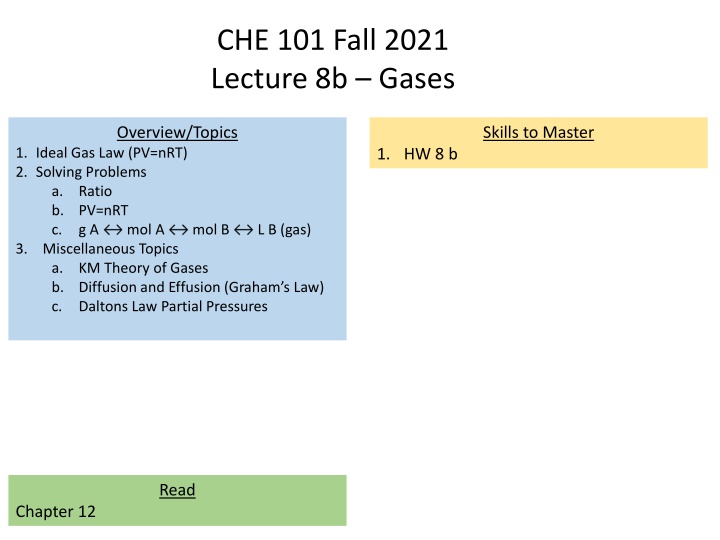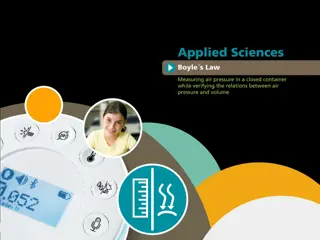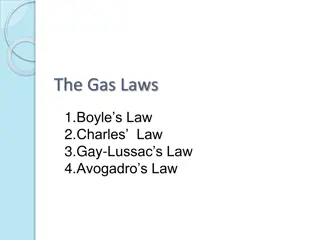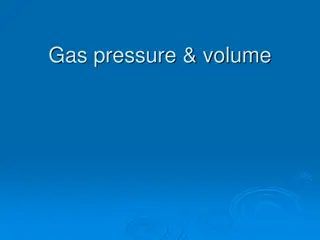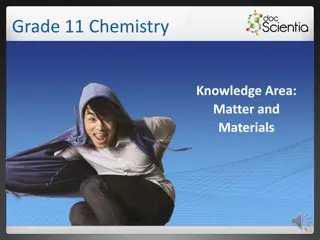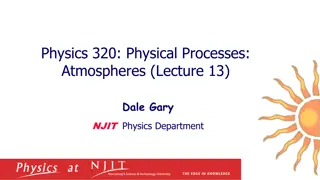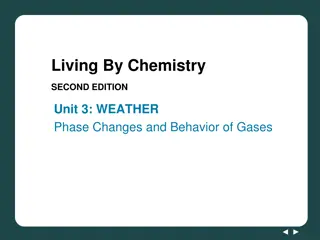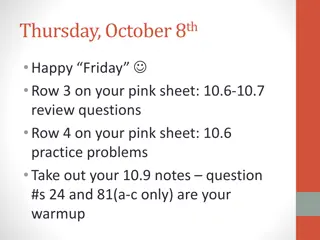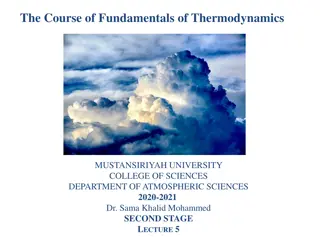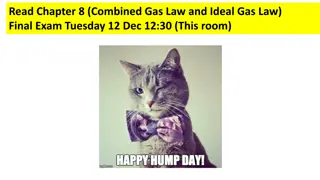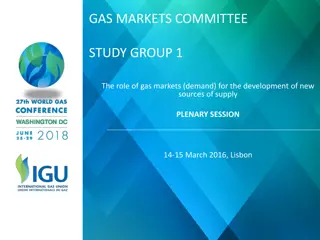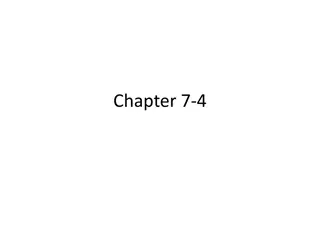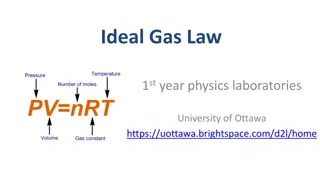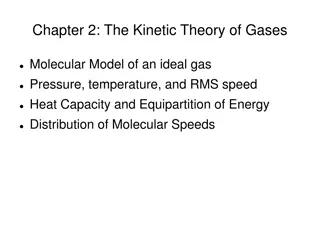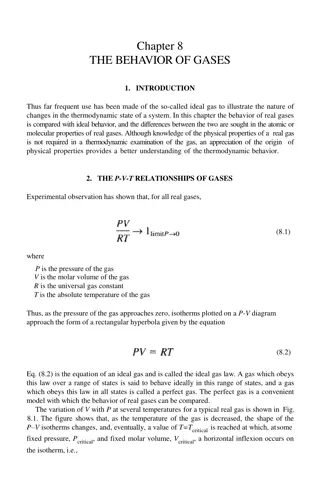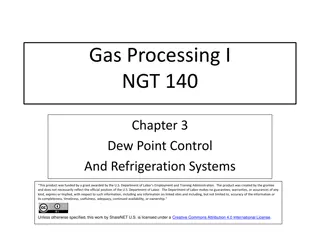Comprehensive Overview of Ideal Gas Law and Gas Problems
Delve into a detailed exploration of the Ideal Gas Law and its applications in solving various gas-related problems. Master the concepts of Boyle's Law, Charles's Law, Avogadro's Law, and more through equation, ratio, and stoichiometry problems. Enhance your understanding of gas behavior and calculations with practical examples and explanations. Embrace the fundamentals of gas laws with this comprehensive guide.
Download Presentation

Please find below an Image/Link to download the presentation.
The content on the website is provided AS IS for your information and personal use only. It may not be sold, licensed, or shared on other websites without obtaining consent from the author.If you encounter any issues during the download, it is possible that the publisher has removed the file from their server.
You are allowed to download the files provided on this website for personal or commercial use, subject to the condition that they are used lawfully. All files are the property of their respective owners.
The content on the website is provided AS IS for your information and personal use only. It may not be sold, licensed, or shared on other websites without obtaining consent from the author.
E N D
Presentation Transcript
CHE 101 Fall 2021 Lecture 8b Gases Overview/Topics Skills to Master 1. Ideal Gas Law (PV=nRT) 2. Solving Problems a. Ratio b. PV=nRT c. g A 3. Miscellaneous Topics a. KM Theory of Gases b. Diffusion and Effusion (Graham s Law) c. Daltons Law Partial Pressures 1. HW 8 b mol A mol B L B (gas) Read Chapter 12
Ideal Gas Law Combination of all 4 Individual Gas Law Boyle s Law (P and V) Charles's Law (V and T) Gay-Lussac s Law or Amonton s (P and T) Avogadro's Law (V and n) Dimitri Mendeleev (1834-1907) Beno t Paul mile Clapeyron (1799-1864) Works well for High Temperature/Low Pressure
Cheat Sheet! Ideal Gas Law Equation Form R = Gas Constant Standard Units P - Pressure (Atm) V - Volume (L) T - Temperature (K) n - Amount (mols) Standard Temperature and Pressure (STP) Pressure = 1 Atm Temperature = 273.15 K (0 C) Ratio Form ?1?1 ?1?1 =?2?2 ?2?2
Ideal Gas Law Problems 3 Types of Problems Equation Problems One set of conditions 1 copy of each variable PV=nRT Ratio Problems ?1?1 ?1?1 =?2?2 ?2?2 Two sets of conditions 2 copies of 1 or multiple variables Stoichiometry Problems (Ch. 6) Too Big to fit here, see next slide! Includes a chemical equation (or you can write one)
Stoichiometry Problems (Ch. 6) Includes a chemical equation (or you can write one) R1 + R2 P1 + P2 A + B C + D Use Reactants or Make Products mol/mol MW MW Grams A Mol A Mol B Grams B PV=NRT Volume B (Gas) Volume A (Gas)
Equation Problems One set of conditions 1 copy of each variable PV=nRT Example: A scuba tank is contains 80.0 L of air at 3000. PSI at room temperature of 20.0 C. How many mols of air are in the cylinder?
Ratio Problems ?1?1 ?1?1 =?2?2 ?2?2 Two sets of conditions 2 copies of 1 or multiple variables Example: A scuba tank is contains 80.0 L of air at 3000. PSI at room temperature of 20.0 C. If the scuba cylinder is heated to 100.0 C what will the pressure in PSI be?
Stoichiometry Problems (Ch. 6) Includes a chemical equation (or you can write one) Example: If you burn 227 g of Ethanol (C2H5OH) at 303 K and 1.0 Atm, how many Liters of O2 gas will be consumed? ___ C2H5OH (s) + ___ O2(g) ___ CO2 (g) + ___ H2O (g) + Heat
Example: If in the previous reaction, you produced 2000.0 L of CO2 (g) and H2O (g), how many grams of Ethanol (C2H5OH) was combusted at 25.0 C and 12.5 PSI? ___ C2H5OH (s) + ___ O2(g) ___ CO2 (g) + ___ H2O (g) + Heat
You Try It: A hot-air balloon at sea level holds 2000. L of air at 20.0 C. If the balloon flies 1.5 miles high the pressure is 0.75 Atm and the balloons volume expands to 2500. L to keep it aloft. What is the temperature of the air inside the balloon? 270 K You Try It: How many grams of ethanol (C2H5OH) must be combusted to blow up a 50.0 L balloon at 1.00 atm and 20.0 C using the following reaction.? 19.1 g C2H5OH _1_ C2H5OH (s) + _3_ O2(g) _2_ CO2 (g) + _3_ H2O (g) + Heat You Try It: A propane tank for your grill holds 250 mols of C3H8 gas in at 50.0 L tank at 20.0 C. What is the pressure inside that tank in PSI? 1800 PSI You Try It: Hydrazine (N2H4) is used as a rocket fuel. If you burn 500.0 g of Hydrazine, how many Liters of gas will be produced at 700. mm Hg and 50.0 C? 1.80x103 L _1_ N2H4 (g) + _3_ O2(g) _2_ NO2 (g) + _2_ H2O (g) + Heat
You Try It: A hot-air balloon at sea level holds 2000. L of air at 20.0 C. If the balloon flies 1.5 miles high the pressure is 0.75 Atm and the balloons volume expands to 2500. L to keep it aloft. What is the temperature of the air inside the balloon? 270 K
You Try It: How many grams of ethanol (C2H5OH) must be combusted to blow up a 50.0 L balloon at 1.00 atm and 20.0 C using the following reaction.? 19.1 g C2H5OH _1_ C2H5OH (s) + _3_ O2(g) _2_ CO2 (g) + _3_ H2O (g) + Heat
You Try It: A propane tank for your grill holds 250 mols of C3H8 gas in at 50.0 L tank at 20.0 C. What is the pressure inside that tank in PSI? 1800 PSI
You Try It: Hydrazine (N2H4) is used as a rocket fuel. If you burn 500.0 g of Hydrazine, how many Liters of gas will be produced at 700. mm Hg and 50.0 C? 1.80x103 L _1_ N2H4 (g) + _3_ O2(g) _2_ NO2 (g) + _2_ H2O (g) + Heat
Kinetic-Molecular (KM) Theory of Gases Ideal Gas Theory Empty Space 1. Gases behave like tiny particles 2. Distance between particles is large (volume is mostly empty space) 3. No attractive forces between particles 4. Move in straight lines, collide frequently 5. Collisions are elastic (no loss of energy) 6. Kinetic Energy (KE) is same for all gases and Temperature (K) No Attractive Forces ?? =1 2??2 Elastic Collisions KE (EK) = Kinetic Energy (J) m = mass (Kg) v = velocity (m/s)
Crowded Empty Space Attractive Forces No Attractive Forces Elastic Collisions Inelastic Collisions
Diffusion o Gases mix spontaneously o Create an uniform mixture o Fill any space
Grahams Law and Effusion Gasses will flow (effuse) out a small hole from high pressure to low pressure rate of effusion A rate of effusion B= Density B Density A= MW B MW A Rate of Effusion is Inversely Proportional (IP) to Mass 1 Rate Mass
Daltons Law of Partial Pressure Just Avogadro s All gases are the same The total pressure of a mixture of gases is the sum of the partial pressures exerted by each of the individual gasses in the mixture Ptotal = P1 + P2 + P3 + = Example: O2 (g) + H2O (g)
